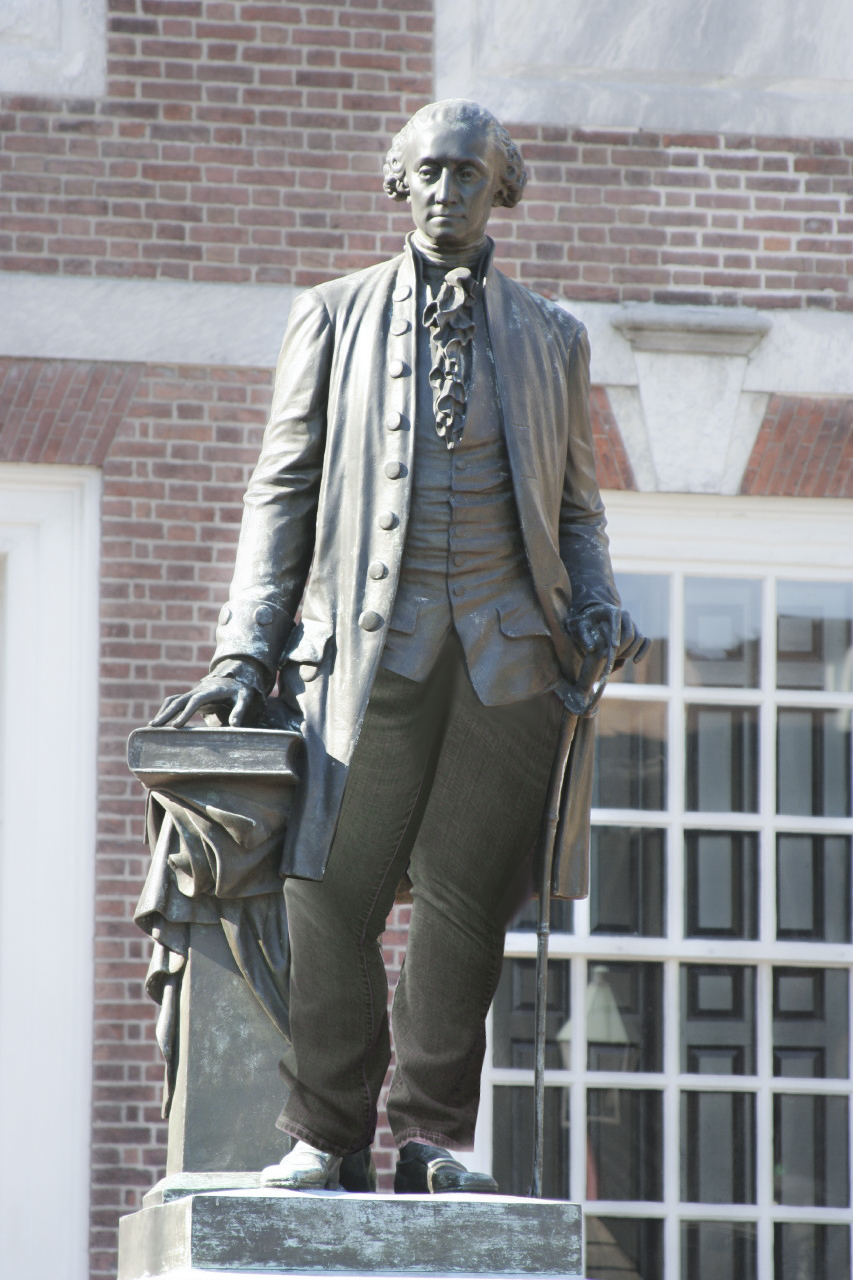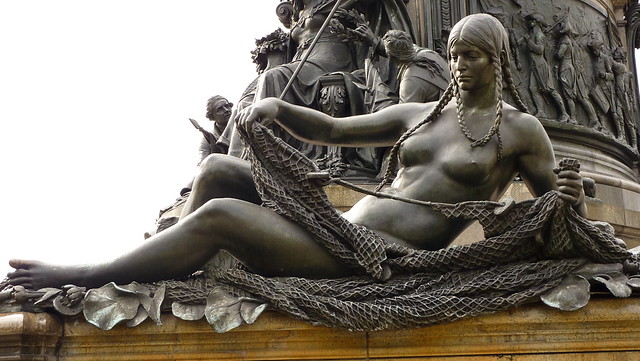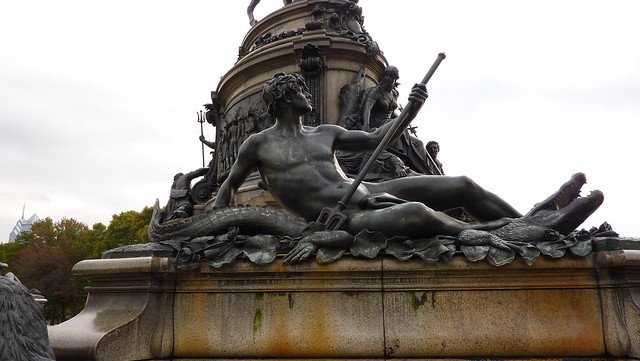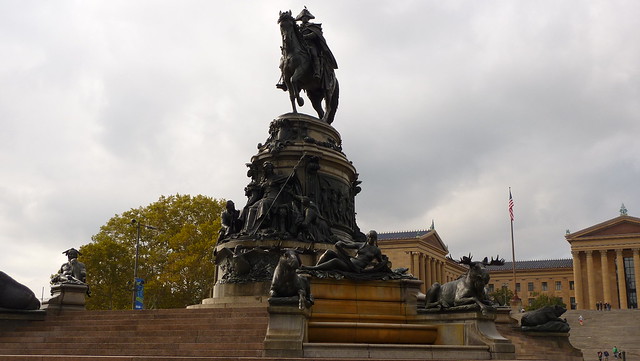
Statue of President George Washington Outside of Independence Hall
From the New York Times, "Reopening a House That’s Still Divided," by Edward Rothsetin -- PHILADELPHIA — The convulsive currents that roil the telling of American history have become so familiar that they now seem an inseparable part of the story itself. Here is a nation, conceived in liberty and dedicated to a proposition of human equality, that, for much of its first century of life, countenanced slavery, institutionally supported it and economically profited from it. The years that followed have been marked by repair, reform and reversals; recompense, recrimination and reinterpretation. Extraordinary ideals and achievements have been countered by extraordinary failings and flaws, only to be countered yet again, each turn yielding another round of debates.

Constance the Constitution Cow, Philadelphia, PA
And here, in this city where the Constitution and the Declaration of Independence were signed; where a $300 million Independence National Historical Park has been created, leading from the National Constitution Center to Independence Hall; and where the Liberty Bell, as a symbol of the nation’s ideals, draws well over a million visitors a year, a great opportunity existed to explore these primal tensions more closely on a site adjacent to the Liberty Bell Center in Independence park. Unfortunately, those opportunities have been squandered in “The President’s House: Freedom and Slavery in the Making of a New Nation” which opens on Wednesday.
It is almost painful, given the importance of this site, to point out that the result is more a monument to these unresolved tensions than a commemoration of anything else. After $10.5 million and more than eight years; after tugs of war between the city and the National Park Service and black community organizations; after the establishment of a contentious oversight committee and street demonstrations, overturned conceptions and racial debates, it bears all the scars of its creation, lacking both intellectual coherence and emotional power. On Wednesday the Park Service takes over the site with its work cut out for it, since rangers will have to weave the competing strands together.

Public Restrooms on the site of the President's House in Philadelphia, PA
But consider what opportunities there were. The construction of a new $9 million exhibition space for the Liberty Bell drew attention to this adjacent site, where the nation’s first two presidents — George Washington and John Adams — had lived between 1790 and 1800, when Philadelphia was the nation’s capital.
The house had long ago been demolished — much of it in the 1830s — and in the 1950s the site, near Sixth and Market Streets, was the location of a public restroom. But the house was once one of the grandest mansions in Philadelphia. Its inhabitants included Richard Penn (grandson of the Pennsylvania colony’s founder); the British general William Howe (who occupied Philadelphia while Washington’s army licked its wounds in Valley Forge); Benedict Arnold (who may have begun his espionage here); and Robert Morris (a financier of the Revolution). All vanished history.
Then, in an illuminating 2002 article in The Pennsylvania Magazine of History and Biography, the historian Edward Lawler Jr. mapped out the house and its probable dimensions, and pointed out the irony that just steps from the new Liberty Bell Center was a site that had once sheltered Washington’s slaves.

George Washington's Statue, Outside of the Philadelphia Museum of Art
The Park Service contested some of his conclusions and refused to outline the footprint of the lost President’s House in its designs for the center. But the issue was soon taken up by scholars, including Gary B. Nash, author of the new book “The Liberty Bell,” as well as by political activists like the lawyer Michael Coard and his Avenging the Ancestors Coalition, who argued that the existence of slave quarters adjacent to the city’s paean to liberty demanded major commemoration.
There was a cascade of events, chronicled by The Philadelphia Inquirer, including Congressional legislation and financing, city oversight and funds, an expansion of the Liberty Bell exhibition, the establishment of an oversight committee and the solicitation of redesigns. In 2007 an archaeological dig began, revealing the foundation and the remains of a tunnel once used by servants and slaves. The dig, viewed by the public, ignited debate.
Washington ultimately took nine slaves to Philadelphia from Mount Vernon, where more than 200 slaves were held. And they were part of a household staff that may have numbered two dozen, including white indentured laborers and servants. Though the slaves were part of a population of nearly 4,000 others in Philadelphia, there were also more than 6,500 free blacks in the city in 1790, and Washington’s slaves were exposed to the experience of liberty.


George Washington's Statue, Outside of the Philadelphia Museum of Art
We know some astonishing details about the effects. Ona Judge (here called Oney), a servant to Martha Washington, and Hercules, the household cook, both escaped to freedom.
Some of Washington’s most unattractive characteristics also emerge. He and Martha Washington pursue Judge for years, though she later establishes herself with her own family in New Hampshire. And though Washington expressed his opposition to slavery, and freed his own slaves in his will, he went through bizarre machinations to ensure that the slaves he took to the nation’s capital would not be subject to local laws granting them freedom after six months. He exchanged them with others at Mount Vernon, issuing instructions: “I wish to have it accomplished under pretext that may deceive both them and the public.”
So here we not only have the father of our country showing his darkest side, we also see the foundations of the nation at their darkest. Yet here is where Washington invented the executive branch, conducting affairs of state. Here is where it became clear that a democratic ruler was no king, had no claim on his dwelling place and was himself meant to serve the people.

How, then, should such a site be developed? A 2005 call for designs stressed that it would have to pay attention to many themes: the house, its workers, the executive branch, African-American Philadelphia, escapes to freedom. In addition, it noted that community discussions led to five “cultural values” that should be clear: identity, memory, agency, dignity, truth. There was also a requirement that the site be open 24/7 to visitors.
As ultimately designed by Kelly/Maiello, the site is a space bounded by a low wall roughly outlining the footprint of the house (but often departing from it), marked by protruding rectangular slabs into which are inserted mock fireplaces and video screens. In the house’s heart, a transparent wall allows visitors to view the archaeological work in progress. And attached to the walls are either long panels surveying historical themes — the executive branch, slavery in the President’s House — or rudimentary illustrations. A few show the escape of Judge, a few give some glimpse of foreign policy in the house (protests over the Jay Treaty with England), and more give some sense of slavery (including Washington’s signing of the Fugitive Slave Act, which put all escaped slaves in danger).
“History is not neat,” we read. “It is complicated and messy. It is about people, places and events that are both admirable and deplorable.” And the President’s House, we are told, “exposes the core contradiction at the founding of this nation: enshrinement of liberty and the institution of slavery.”

But what precisely is being exposed? A few yards away, the Liberty Bell Center discusses abolition and slavery; the park’s visitor center has an exhibition about the Underground Railroad; the nearby African American History Museum has a powerful audio and video history of blacks in Philadelphia. Accounts of slavery are even found at Mount Vernon.
Here, though, we get neither a sense of the place, nor a sense of the issues (and much of the year, the open air will be inhospitable). We don’t learn about the differences between Washington and Adams. We don’t learn much about the pictured events. There is no real narrative. Illustrations can also be melodramatically contentious: we see a seemingly disdainful Washington dangling a “peace medal” before a suspicious Seneca Indian leader
As for slave life, it is also difficult to piece together. The video screens that come to life above the fake mantels give the impression of a half-finished 21st-century home. The videos themselves (with scripts by Lorene Cary), in which slaves and servants provide first-person accounts of experiences, at least provide some sense of life. But how do we put these experiences in context? What was Philadelphia’s free black community like? How did white workers and black slaves live together here?

We are told that the President’s House “offers an opportunity to draw lessons from the past.” But what lessons? That Washington was flawed? That slavery was an abomination? Are these revelations? A memorial to the practice of slavery is mounted here, inscribed with the names of African tribes from which slaves derived, but it has no particular relationship to Philadelphia or this site. The need for some such memorial is keen, but here it seems thumped down as an intrusion.
So what is learned? Not what makes this site special, but what makes it ordinary; not the foundations of what led to the overcoming of slavery, but a sense of its enduring presence. Would this display be any different if presidents had not lived here? And would our understanding be any different without it?
“The President’s House” opens on Wednesday in Independence National Historical Park in Philadelphia; phila.gov/presidentshouse. [source: New York Times]


RON'S RANT: Here is a presentation that exposes the disjointedly amateurishness of the Slaves at the President's House in Philadelphia. Everything about this presentation is painful to watch, the lighting is bad, the audio is bad, the powerpoint is bad and preparation is a big WTF didn't ANYBODY prepare their remarks!
I visited this site a couple of weeks ago with my family (Middle of May in 2012). The above New York Times article, expresses my disappointment in the execution and presentation of the narration. George and Martha Washington's slaves follow the trajectory of American History. They are like the "Forrest Gump" of slaves. They served George Washington's family before the Revolution, his body servant was like his sidekick in all of the battles that George Washington fought. They show-up in Martha Washington's correspondence with Abigail Adams and Dolly Madison. George Washington kept impeccable records regarding his slave property. Martha Washington's dowry slaves became the slaves of General Robert E. Lee in Arlington, Virginia.

The group that did the President's House Project needed to do more research at Mount Vernon and Arlington National Cemetery -- I'll bet that the remains of the dead slaves are buried at Arlington National Cemetery. The slaves of George and Martha Washington are some of the most documented enslaved people in the USA. How and Why the committee didn't do their research baffles me for sure.
The slaves of George and Martha Washington tell a great story of American History from the French and Indian Wars through the Civil War (remember Gettysburg is in Pennsylvania, too). Why was this group chosen to tell their story so poorly? Nobody can say it was about money. I'm a nobody from nowhere, flat broke and I don't earn a freaken dime from this site, but it's a labor of love. I do my homework and research to try to add heat as well as light to the story of slavery. I do this for NOTHING, yet these clowns waste millions upon millions of dollars to produce a disappointing mishmash of history. -- Ron Edwards, US Slave Blog
History as Cultural Work: The President's House Project in Philadelphia
I visited this site a couple of weeks ago with my family (Middle of May in 2012). The above New York Times article, expresses my disappointment in the execution and presentation of the narration. George and Martha Washington's slaves follow the trajectory of American History. They are like the "Forrest Gump" of slaves. They served George Washington's family before the Revolution, his body servant was like his sidekick in all of the battles that George Washington fought. They show-up in Martha Washington's correspondence with Abigail Adams and Dolly Madison. George Washington kept impeccable records regarding his slave property. Martha Washington's dowry slaves became the slaves of General Robert E. Lee in Arlington, Virginia.

The group that did the President's House Project needed to do more research at Mount Vernon and Arlington National Cemetery -- I'll bet that the remains of the dead slaves are buried at Arlington National Cemetery. The slaves of George and Martha Washington are some of the most documented enslaved people in the USA. How and Why the committee didn't do their research baffles me for sure.
The slaves of George and Martha Washington tell a great story of American History from the French and Indian Wars through the Civil War (remember Gettysburg is in Pennsylvania, too). Why was this group chosen to tell their story so poorly? Nobody can say it was about money. I'm a nobody from nowhere, flat broke and I don't earn a freaken dime from this site, but it's a labor of love. I do my homework and research to try to add heat as well as light to the story of slavery. I do this for NOTHING, yet these clowns waste millions upon millions of dollars to produce a disappointing mishmash of history. -- Ron Edwards, US Slave Blog
History as Cultural Work: The President's House Project in Philadelphia
In Short, If people would read, Think, and ponder on our history and look at the whole picture, We would solve alot of our racial tensions today. We broke off the chains of one tyrant and oppressor King James with the Puritans , Mayflower and colonization of America .With them came the Ideology and norm at the time Massachusetts Bay Colony, Plymouth Colony, Oath of Freemen etc.Not long after , America was dealing in world commerce, the 13 colonies like Europe and other nations utilized the horrible idea of slavery to compete. But here is a question, looking back in 20/20 hind site, with the racial tensions it created today, the suffering the slaves lived then and endured, and the hypocrisy they created for themselves and for us, would they of abandoned the practice and find a different method of competing ? Maybe! But then again, would you have a large if any African American population in America today. It was a different world back then. The next 200 yrs was more concerned with over throwing the rule of England and King George. When that was finally achieved in the Revolutionary War.( in all honesty the only war America has ever won), Like Some one said earlier,'' History is not all was neat and pleasant'' It had its hypocrisies as evident in the Founding Fathers.But America was focused on the Revolution and freedom from England, and probably not so focused and willing to give a deplorable and hypocritical luxury as slavery. And haven't even addressed the wrongs of the native american Indians which is similar in regard. But it seemed necessary it was the next step this nation had to face and address in due time with the Civil War then Civil rights and such. So why am I writing? I want peace. I want this nation to move past all this. But Lets not throw out the baby with the bath water. Lets not bear the transgressions of the our Founding Fathers who did wrong in regard of Slavery , but had sacrificed and suffered in a different way. Our freedom from England came at a great cost. And also, lets not Judge the past by today's standards and political correctness, because it will never end going clear back to the dawn of time. And lets think of and appreciate the freedom we all have as a result of all, slaves , Founding Fathers, colonizers, and men like the Great Fredrick Douglas, Lincoln and such. God Bless . Niel
ReplyDelete